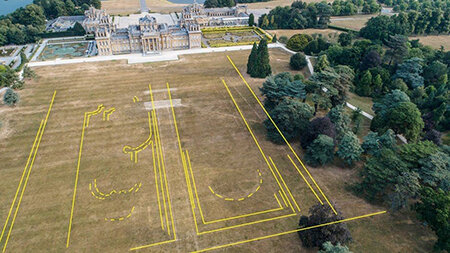Parch marks the spot
/Blenheim Palace parch marks, BBC.
In a monoculture such as grass or a cultivated crop, the conditions in the subsoil can be revealed above ground as a tell-tale pattern, particularly in dry years when the localised scarcity of water shows up as a parch or scorch mark – often over hard landscaping such as walls or paths. Conversely, flower beds will tend to show as areas of lusher growth because of the water retention of the humus-rich compost that gardeners will have dug into them. Parch marks are most easily spotted from the air and the advent of drones has made rapid surveys more straight forward and inexpensive.
Plan of Parterre, 1719, Blenheim Palace Archives
In the dry summer of 2018, a drone image confirmed the accuracy of the 1719 plan of the gardens at Blenheim Palace. The parterre close to the Palace, which the parch marks revealed, was part of the Bastion Garden and its hexagonal ‘Wood-work’ covering circa 70 acres. The garden lay-out was probably a result of a collaboration between the architect Sir John Vanbrugh and the Royal Gardener Henry Wise and was created for the 1st Duke and Duchess of Marlborough.
The Palace Archives supply a detailed picture of the scale of the planting of the Parterre. In the ‘Wood-work’ alone Henry Wise supplied 9,357 hedge yews as well as ‘5,900 hornbeam, privatt and sweet bryer’. Stephen Switzer, who worked for Wise, later said that ‘out of about ten thousand Hedge-yews etc. that were planted under my direction at Blenheim in 1706, there were not two hundred that fail’d.
The Parterre would have matured relatively quickly but the Duke seems to have desired Henry Wise to accelerate certain aspects of the layout because according to Daniel Defoe:
his Grace bad him consider, he was an old man and could not expect to live til the Trees were grown up; and therefore he expected to have a garden as it were ready made for him. Accordingly, Mr Wise transplanted tither full-grown Trees in Baskets, which he bury’d in the Earth, which look and thrive the same as if they had stood there thirty or forty years.
His Grace was right to be concerned since the garden was not finished until 1723, a year after he died.
Gawthrope Hall, Metro.co.uk
Gawthorpe Hall in Lancashire has been owned by the Shuttleworth family since the 14th century until it was gifted to the National Trust c.1970. Sir Charles Barry was called in during the 1850s to restore the Jacobean house and he laid out a small ornamental terrace garden. It was removed in 1946 but the outline of the flower beds can be seen clearly in dry years, highlighted by the comparatively lush growth of grass.
Gawthorpe Hall, Metro.co.uk





